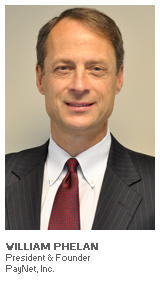
To kick off the New Year, Equipment Finance Advisor visits with William Phelan, President of PayNet to gain an understanding of what may be in store for the equipment finance industry in 2015. In this Q&A, we elicited Phelan’s views on the impact the private company economy will have on overall equipment investment in 2015.
Equipment Finance Advisor: According to the 2014 Q3 Small Business Credit Outlook by PayNet, sentiment among small business owners is improving. You’ve called this the “Great Normalization”. What primary economic factors are business owners seeing that are influencing this shift?
William Phelan: By the Great Normalization, we are describing the shift from a fear based market to a normal risk taking market. This shift is hard because the scar tissue from the Great Recession remains. The U.S economy typically operates with greater risk met with greater reward. This wasn’t the case in 2010 and 2011 – which was an era of flight to quality and survival. We have finally moved into normal risk taking, which is healthy – meaning the psyche of the business owner and their level of optimism is becoming more positive. And the economic expansion is fanning out and participation is evident in more industry sectors and across more geographic areas of the U.S. We can see in the data that businesses are investing above the replacement cycle now. They are moving into a phase of organic growth which is driven by demand for their goods and services.

EFA: How would you describe the financial condition of these companies today? Has the financial condition of these companies impacted where money is being invested?
Phelan: The financial health of private businesses is strong – as a matter of fact, we have never seen them stronger. Delinquencies are just above the all-time low – having reached 1.25% in October 2013. They are up about 10 BPs in November, but they’re still at relatively low levels. No one knows how much cash is on the balance sheets of these businesses, but what we do know is that they are finding it much easier to pay their bills and they are putting debt on the books for their investments. So the finances of small- and medium-sized companies are in good shape.
It’s important to remember that small company owners are a smart group. They don’t invest unless they are pretty certain about prospects for success. We see certain industries working to reduce their expenses when top line growth is not evident – driving a different form of investment. For example, manufacturing has not seen quite the lift experienced in other sectors. I was speaking with the CEO of a $50MM manufacturing company who told me his orders are down 6% year-over-year. But, over the past few years he has “right sized” his business to make money at this lower order level. Today he is investing 20% less in PP&E than he would if his business was experiencing growth. Because his orders are down, his best investment now is a solar panel system. So, while the top line isn’t growing, the company is addressing its expense structure by reducing its energy costs – in essence it is right sizing the business for this new economy, which is also part of the normalization.
EFA: The latest report indicates the Small Business Lending Index (SBLI) is “within striking distance” of its all-time high of 131.7 achieved in January 2007. Is it feasible the index could exceed the all-time high in 2015? If so, what does this mean for the equipment finance industry?
Phelan: GDP is up 35% since 2005. Meanwhile, investment as exhibited in the SBLI is up about 30%. There’s about a 5% gap in investment by these small businesses versus GDP. These companies have been reluctant to invest, but there is a lot of pent up demand. We believe the GDP/SBLI gap will close and the amount of investment made by private companies through various forms of equipment financing will catch up with GDP on a relative basis. This is good news. There’s quite a bit of growth potential left in the U.S. equipment finance industry because these companies will invest at about an equivalency rate to GDP. So we see 2015 having very good potential for more originations.
EFA: Is the fact that we are in a period of slower growth in return for longer expansion truly a positive in terms of sustainability? Is this a healthier model?
Phelan: Regulators have put laws and rules in place to reduce credit risk. My view is these regulations are intended to reduce the likelihood of investment bubbles. My sense is that regulators are trying to maintain some level of control which dampens growth and could be viewed as bad news by some. One possible benefit is greater longevity of the expansion – fewer booming times along with fewer busting times. We see it today in the data. We are in a low risk expansion phase – which means the delinquencies and default rates are very low while the equipment investment rate is double digit. However, today’s low risk expansion phase is at a slower rate of growth than the same phase in 2005 and 2006. Whether it’s intentional by the regulators or not, I cannot comment, but it seems to me that when you put more controls in place, it will tend to dampen the availability of easy credit. This will tend to keep some pent up demand in place for capital. One side effect is a longer business cycle.
EFA: Many equipment finance professionals have described the lending environment as hyper-competitive. Do you believe this will it continue through the normalization?
Phelan: Yes, but the economics have changed considerably. The cost of risk is much lower today than it was in 2005 and 2006. Also, interest rates are much lower today than during that same time period. Real rates of return to compensate for credit risk have not changed. As an industry, we need to get used to the different economics of conducting business. Credit defaults hit 1.2% by year-end 2013, and we know defaults will still be well below 2% in 2014. The long-term average is in the 2.5% - 3.0% range. The lower costs of credit can offset some spread compression. As credit costs rise and markets remain hyper competitive in 2015, CEO’s will have to adjust pricing.
The economy is different now and equipment finance companies must understand where the investments opportunities are today as well as the economics of the deals today, and adjust their business models to adapt to this new economic environment.
EFA: In past interviews, you’ve commented that the U.S. economy is shifting from a manufacturing-based economy to a services-based economy. Will this create greater than historical demand for financing soft assets and services?
Phelan: Yes, soft assets and services will be a greater focus next year. There was a big uptick in manufacturing investment in 2011 and 2012 as a result of tax credits and bonus depreciation availability. But it doesn’t appear that all that capacity has been utilized, and we don’t see manufacturing experiencing a big lift in investment. As an economy matures, services become a more integral part, and I think the commercial finance industry will continue to discover ways to finance these changing service needs.
EFA: Please provide our readers with some insights into the specific sectors you believe will perform well (and not so well) in 2015?
Phelan: Even with the SBLI in record territory, we see more capacity for additional investment. Using the data available through November 2014 we have seen big investments in select sectors; transportation and warehousing up 27% year-over-year, accommodation and food services sector – up 17%, construction up 16%, and retail trade (furniture and fixtures) – up 12%. The lagging sectors include manufacturing, agriculture and healthcare.
Some of these sectors are at all-time highs for equipment investment. For example, the SBLI for transportation and accommodation and food are at all-time highs. Some CEO’s I’ve talked to are becoming cautious concerning opportunities for growth. Because they’ve had a good run they certainly have less room to grow. However, sectors with room to grow include construction – which is still well below its all-time high despite the significant growth already experienced. We are estimating the construction sector has 36 points, based on the SBLI, of potential growth in this business cycle. In addition, manufacturing has room to grow and retail trade as well.
The bottom line is that the U.S. is a massive economy that is dynamic and constantly changing. This economy is different than the one in 2005- 2006, so execs need to adjust.
EFA: How influential is the U.S. private company economy on the overall U.S. economy and global economies?
Phelan: The U.S. private company economy makes up about 50% of all GDP in the United States. That is almost as big as the entire GDP of China. It’s larger than the combined economies of Germany, France and Great Britain – so it’s an enormous economy. What provides so much optimism is the fact that there is investment going on in this sector of the economy. Business leaders are reacting quickly to demands for goods and services and the equipment finance industry is providing the growth capital.
I think U.S. private companies can drive domestic growth in the U.S. in 2015. These companies will look to equipment finance lenders as a major source of capital to fund their growth. Absent a derailing event like a terrorist attack, U.S. private companies funded by equipment lenders can be one major source of growth for the global economy in 2015.